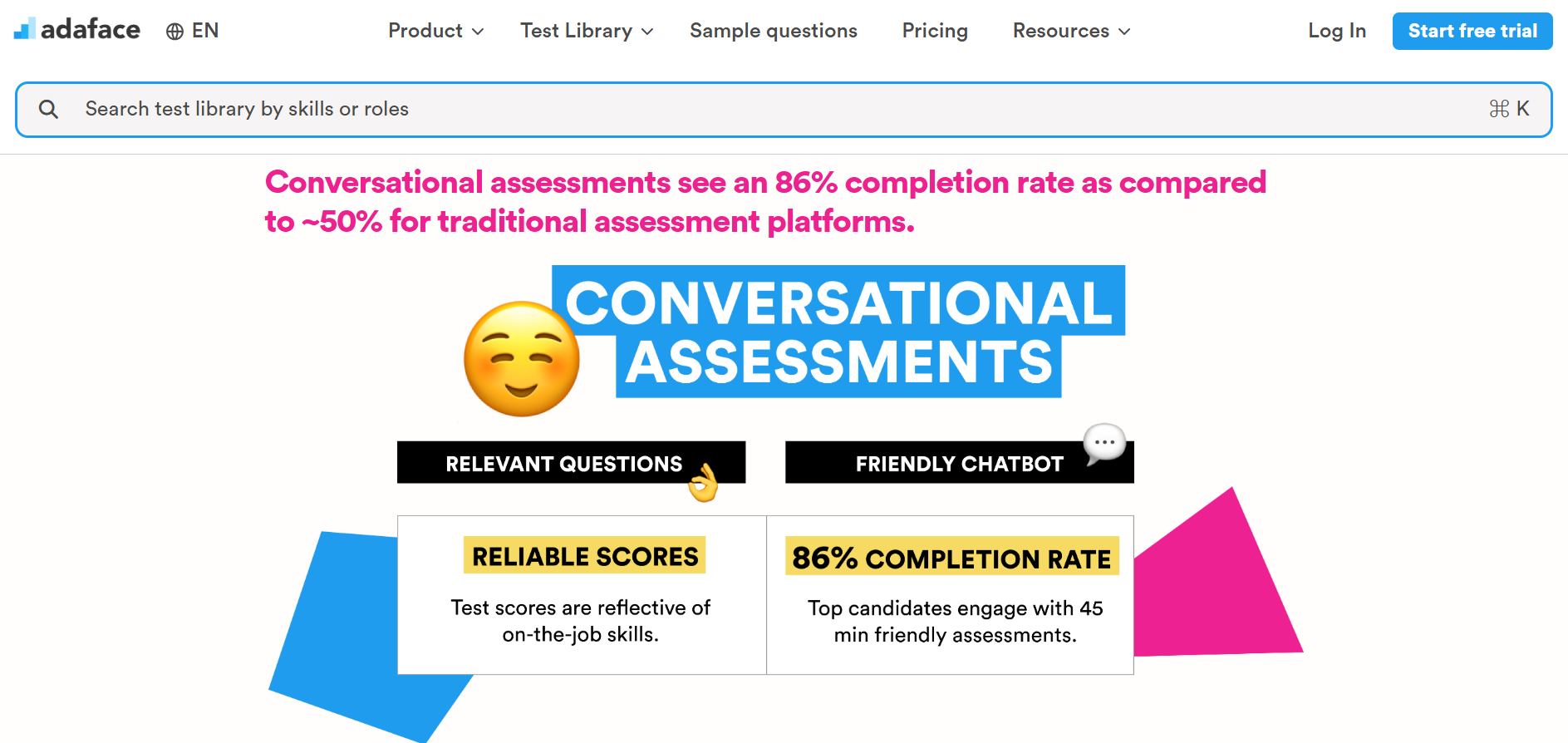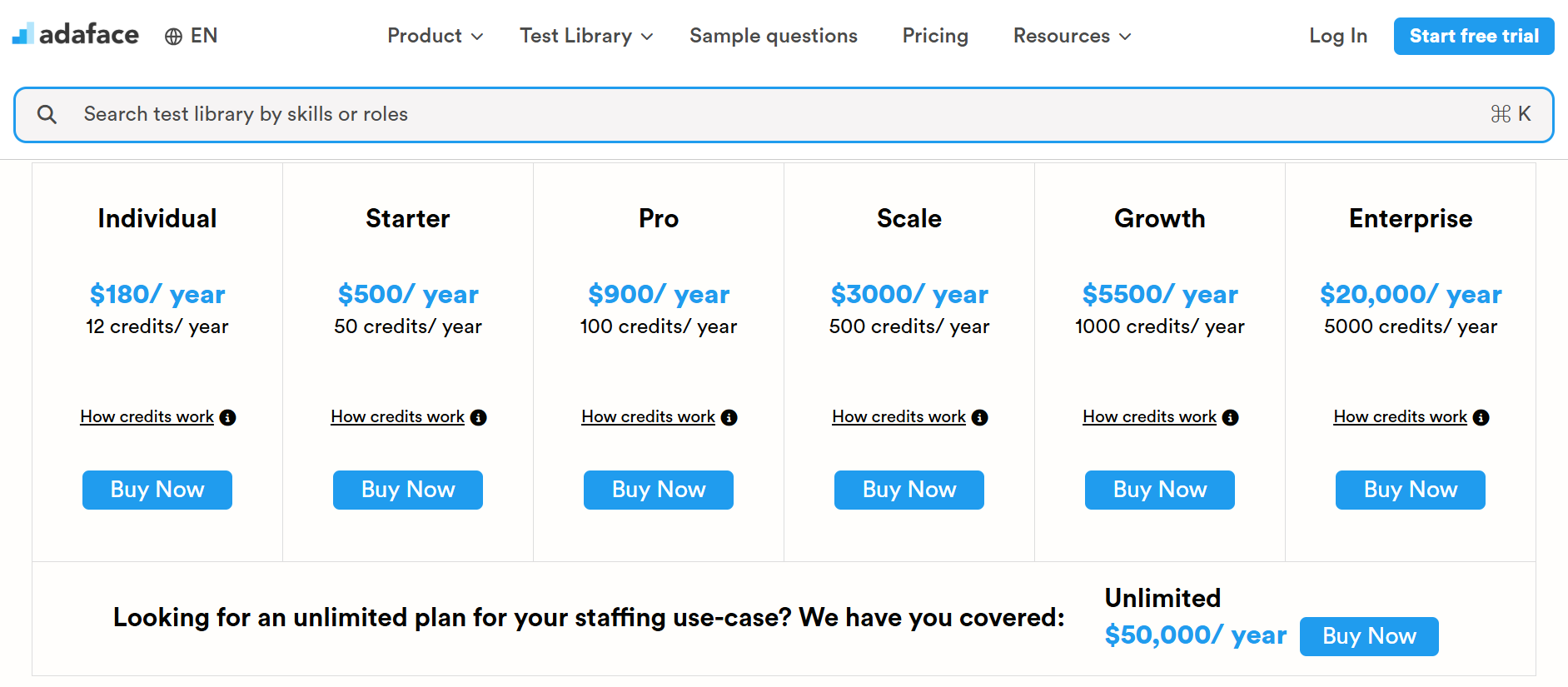Adaface entered the B2B assessment space in 2019-2020 with a distinct proposition: chatbot-led, conversation-style assessments delivered through their AI bot “Ada.” While most talent skills assessment platforms chased the North American market, Adaface focused on Southeast Asia, tapping into the region’s growing demand for tech hiring tools. It was a bold bet and an early differentiator in a crowded market.
Table of Contents
However, as of 2025, a closer look suggests that momentum may have stalled. Here’s a breakdown of what’s working, what’s not, and why many customers, including public sector entities, are now exploring Adaface alternatives.
TL;DR – Key Takeaways!
- Chatbot-led assessments felt novel but didn’t deliver speed or scalability.
- No product updates or roadmap in over a year.
- Lacks customer support, onboarding, and demo options.
- Pricing is rigid, and the question bank is shallow.
- Founders appear disengaged, signaling a lack of long-term investment.
What Worked for Adaface: The Chatbot-Led Assessment Concept

Adaface’s main selling point was its AI chatbot “Ada” that delivers assessments in a conversational style. This approach promised a more engaging candidate experience by simulating a dialogue instead of traditional multiple-choice questions or coding tests.
- Engaging for candidates: the conversational style can feel more human.
- Differentiated offering: stood out from the typical test formats.
What Didn’t Work: Limitations Holding Adaface Back
Despite the novelty, several challenges slowed adoption and effectiveness:
Chatbot-Based Assessments: Interesting, but Not Impactful
At the heart of Adaface is “Ada,” the chatbot that engages candidates in conversational assessments. While this format seemed modern and interactive, its real-world effectiveness has raised concerns:
- Slower candidate experience compared to structured assessments.
- Difficult to benchmark answers fairly across candidates.
- Lack of visibility into test flow and logic
- Limited ATS integrations, making workflow automation difficult.
In contrast, traditional structured assessments (MCQs, coding tests, scenario-based questions) offer faster insights, cleaner analytics, and are easier to scale across roles.
The premise was appealing. But in execution, recruiters need speed, signal, and structure, not simulated chat. The chatbot format, unfortunately, doesn’t scale well for these needs.
Product Hasn’t Evolved in Over a Year
There have been no notable product updates or feature releases in over 12 months. That’s significant in a space that’s constantly innovating with AI, automation, and workflow integrations.
- No visible roadmap or upcoming features
- No new skill tests or content expansion
- Stagnant reporting and analytics dashboards
This product stagnation is a key reason why many customers are now switching to its alternatives, offering continuous innovation and AI-backed customization.
Support, Demos, and Customer Success: Largely Absent
Unusual, but a lack of customer-facing infrastructure makes it hard for teams to trust Adaface for long-term or large-scale implementations. Essentially this means
- No live demo option for new customers, unusual for a paid B2B tool.
- No dedicated customer success or support channels.
- Onboarding is 100% self-serve, which is difficult for HR teams unfamiliar with test curation.
In contrast, modern hiring platforms offer white-glove onboarding, dedicated customer success managers, and responsive support to ensure smooth enterprise rollouts.
Pricing Model: Restrictive and Misaligned with Value


Adaface’s pricing structure creates friction rather than flexibility:
- All assessments are capped at 40 minutes, regardless of role complexity.
- Creating a new test consumes 10 credits, even for small modifications.
- Limited question bank (<1,000 items), pushing users to build from scratch.
- “Non-googleable” questions claim that several candidates have reported recurring, predictable patterns.
This means you’re often paying for the right to build the test yourself, with no depth, limited flexibility, and questionable integrity.
Is Adaface a good value for money? Many buyers are starting to question this due to the pricing restrictions and outdated content pool.
Founders Have Moved On?
There’s little to no founder presence in recent product updates, webinars, or community interactions. Several signs suggest that leadership attention may have shifted to new ventures, leaving the product in maintenance mode.
For enterprise buyers, founder disengagement is a major risk signal, especially in early-stage SaaS. It’s a major checklist for purchasing pre-employment testing software.
Is It Time to Consider an Adaface Alternative?
Adaface deserves credit for entering the market with a novel approach and clear regional strategy. But staying relevant in the hiring tech space demands relentless evolution, customer-first support, and deep product focus.
As of 2025, the challenges with Adaface include
- Product stagnation
- Lack of feature innovation
- Limited assessment depth
- Weak support infrastructure
- Rigid pricing
- Unclear leadership direction
These issues have caused many organizations to evaluate more dynamic platforms. If you’re looking for scalable, integrated, and continuously evolving tech hiring assessments, explore Xobin! The best Adaface competitor, because choosing the alternative might be your best move.
Book a personalized demo with Xobin and explore how AI-powered assessments can boost hiring accuracy, scalability, and candidate experience without the limitations!
FAQs
Is Adaface worth the investment?
Adaface’s rigid pricing model, capped test times, and limited question bank have raised doubts about its value. Many users feel they pay more while doing most of the work themselves.
2. Why are companies switching from Adaface in 2025?
Stagnant product development, weak customer support, and a lack of innovation are key reasons why organizations are seeking better platforms.
3. What are the major limitations of Adaface’s chatbot assessment format?
Chatbot-style tests are harder to benchmark, slower to complete, and lack visibility into test logic, making them difficult to scale for large hiring needs.
4. What is a good Adaface alternative in 2025?
Many users are turning to platforms like Xobin, which offer structured online assessments, deeper question banks, real-time analytics, and full ATS integrations.






